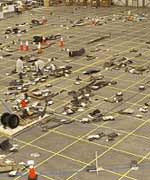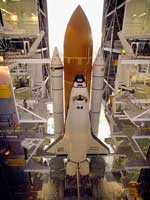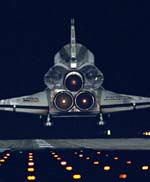NASA marked a major milestone for the Space Shuttle’s Return to Flight, as the redesigned External Tank rolled out today from the barge that carried it to the agency’s Kennedy Space Center (KSC), Fla.
The tank was taken to the Vehicle Assembly Building (VAB) for a final checkout. It will eventually be attached to the twin Solid Rocket Boosters and the Space Shuttle Discovery for its Return to Flight mission, STS-114.
“With the arrival of the External Tank, all of the elements of the Space Shuttle system are in place for Return to Flight,” said Michael Kostelnik, deputy associate administrator for International Space Station and Space Shuttle programs. “This improved tank will be the safest we’ve ever flown. The modifications we have made will ensure the Shuttle completes its long-term mission of assembling the International Space Station,” he said.
NASA and Lockheed Martin Corp. spent nearly two years modifying the 15-story, rust-colored tank to make it safer. Among dozens of changes is a redesigned forward bipod fitting to reduce the risk to the Shuttle from falling debris during ascent. Reducing the debris risk was a key recommendation of the Columbia Accident Investigation Board.
“Although we can never completely eliminate insulating foam coming off the External Tank, we have absolute confidence we have eliminated the type of debris that caused the loss of Columbia,” said Bill Parsons, Space Shuttle program manager. “This tank is safe to fly the Return to Flight mission.”
The External Tank arrived at KSC after a 900-mile journey at sea. It departed NASA’s Michoud Assembly Facility in New Orleans on Dec. 31. It was transported via Pegasus, NASA’s specially designed barge. The Solid Rocket Booster retrieval ship Liberty Star brought the barge to Port Canaveral yesterday. The barge was moved by tugs to the KSC Turn Basin, the tank off-loaded and transported to the Vehicle Assembly Building.
“The team here at KSC is tremendously excited to receive the final Shuttle element for the Return to Flight mission,” said Mike Wetmore, director of Shuttle processing at KSC. “We have an experienced team in place that will complete the final checkout and processing of the tank and prepare it for its final journey out to the launch pad before flight.”
In the VAB, the tank will be raised to a vertical position. It will be lifted high up in the transfer aisle into the “checkout cell,” where the tank’s mechanical, electrical and thermal protection systems are inspected. The tank will also undergo new processes resulting from its re-design, including inspection of the bipod heater and External Tank separation camera.
The tank will be prepared for “mating” to the Shuttle’s Solid Rocket Boosters. When preparations are complete, the tank will be lifted from the checkout cell, moved across the transfer aisle and into High Bay 1. It will be lowered and attached to the boosters, which are sitting on the Mobile Launch Platform.
The arrival of the External Tank, the largest element of the Space Shuttle system, follows other recent Return to Flight milestones, including the “stacking” of the Solid Rocket Boosters in the Vehicle Assembly Building and installation of the Space Shuttle Main Engines into Discovery. The External Tank is the only Shuttle component not recovered after launch and reused.
The Return to Flight mission is targeted for a launch window beginning in May. The seven-member Discovery crew will fly to the International Space Station primarily to test and evaluate new procedures for flight safety, Shuttle inspections and repair techniques.
The Space Shuttle Propulsion Office at NASA’s Marshall Space Flight Center, Huntsville, Ala., manages the tank project. Lockheed Martin Space Systems Co., New Orleans, is the primary contractor.
Video b-roll and sound bites of the tank shipment and arrival will be broadcast on NASA TV. Satellite coordinates and NASA TV schedules are available at: http://www.nasa.gov/ntv
For information on NASA’s Return to Flight efforts, including fact sheets and photos about the tank shipment, visit: http://www.nasa.gov/returntoflight
Original Source: NASA News Release



